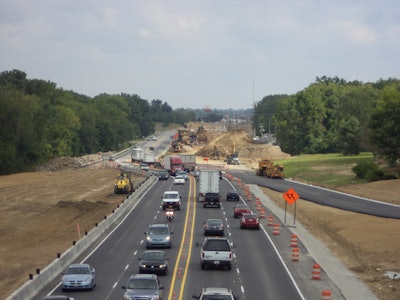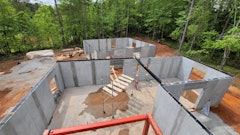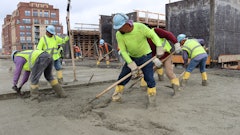
U.S. Route 31 runs from Spanish Fort, AL, to Mackinaw City, MI. In Indiana, the highway enters the state via the George Rogers Clark Memorial Bridge between Louisville, KY, and Clarksville, IN. The 266 miles of U.S. 31 that lie within Indiana serve as a major conduit for the state.
One stretch of U.S. 31 is the main artery to and from Indianapolis from the north. While the pavement was in need of resurfacing, there was a higher purpose in the reconstruction of this segment on this highway.
This stretch of U.S. 31 – from 169th Street to 203rd Street in Westfield, IN, was one of the final road improvements funded by Indiana’s former Governor Mitch Daniels’ “Major Moves” campaign. The aggressive 10-year transportation plan started in 2005 to significantly improve and expand Indiana’s highway infrastructure. Major Moves was funded in part by the $2.6 billion generated by the leasing of the Indiana Toll Road.
The desire to convert this stretch of highway, which was approximately 23 lane miles, into a limited access highway was the primary reason for the project, says Eric Jordan, project manager with Rieth-Riley Construction Co., who won the bid for the U.S. 31 reconstruction.
“Not only was the main road of U.S. 31 completely rebuilt, including elevation changes, but the crossroads were redesigned and rebuilt with roundabouts and other improvements,” he says.
Because of the nature of the reconstruction, this was a high profile project for Rieth-Riley, which specializes in asphalt and concrete paving, site preparation and excavation, bridge construction and underground utility installation and has locations in both Indiana and Michigan, and others.
“This project went directly through a main artery on the north side of Indianapolis,” says Jordan. “Besides the significant traffic, the route winds its way through an affluent area with many prominent businesses along the route. It was an important project for the state of Indiana, INDOT and the City of Westfield to minimize traffic delays and business interruptions, as well as the safety of the traveling public and construction workers.”
Reconstruction process
The project was started in September 2013 and was just recently completed in mid-October 2015.
Rieth-Riley completed nearly 75% of the $60 million project with its own labor force and equipment. One of the first steps of the project was removing 1.5 million square feet of a combination of asphalt and concrete pavement. This, like the majority of the project, was completed in two different phases, southbound then northbound, explains Jordan.
After the pavement was removed, 300,000-plus cubic yards of dirt was imported to the site to build up the grade nearly 25 feet to carry the new U.S. 31 over four intersection previously controlled by traffic signals.
Rieth-Riley completed all bridge construction themselves at the four locations, says Jordan.
“The imported dirt was retained at the bridges by 200,000 square feet of mechanically stabilized earth (MSE) walls installed by Rieth-Riley,” he says. “The final layer of dirt below the 14 inches of asphalt was treated with cement.”
The 14-inch dry cement subgrade treatment was used below 90% of the pavement. “Our subcontractor, Mt. Carmel out of Illinois, performed this work,” says Jordan. “After the cement was introduced into the subgrade, a 72-hour cure time was observed prior to paving.”
Rieth-Riley worked closely with the Indiana DOT (INDOT), whose designers determined the pavement design. Approximately 200,000 tons of asphalt were laid in five layers totaling 12.25 inches deep. INDOT 401 QC/QA mixes were used due to proven reliability, says Inniger.
“As the project moved along, there were some alterations made, such as switching from a slurry to dry cement subgrade treatment,” says Jordan.
New drainage was also installed throughout the four miles to accommodate the drastic elevation changes of the highway.
Rieth-Riley utilized Caterpillar equipment with GPS systems.
“Rieth-Riley has made significant investments in GPS, much of which to help construct US 31,” says Jordan. “Dozers, graders and excavators equipped with GPS were used to more efficiently handle dirt and stone. Our GPS robotics were used to establish line and grade for precise concrete placement.
“This project helped further develop our use of GPS and resulted in more accurate and timely results,” he says.
Challenges
Traffic control was a major consideration in this reconstruction project. Commuters on U.S. 31 move through one of the busiest access routes in the city.
The majority of the traffic was pushed onto existing northbound lanes to construct southbound, explains Jordan. Temporary asphalt widening was added to maintain two lanes in each direction up to 181st street.
North of 181st street, traffic was down to one lane each direction during construction. The new 169th and 181st streets were built under 14-day closures.
“The most complicated potion of the project’s traffic control was the construction of SR 32-which contains heavy traffic in all directions,” says Jordan. “Five phases were required to rebuild SR 32, ¼ mile on each side of U.S. 31, in order to keep traffic flowing through Westfield’s busiest intersection.
“Completion of the project saves commuters significant time from no longer having stoplights throughout the stretch,” says Jordan.
Trucking shortages also became a problem at times as there was significant fill for the raised bridges.
“Pre-planning to minimize how many truck-intensive activities were going on at the same time was crucial,” says Jordan.
“The U.S. 31 project was the largest active job we were doing at the time,” he continues. “The high profile nature of the project within the company and the community gave a sense of pride to all involved.”
The U.S. 31 project was a great success in that it met the objectives of INDOT and the traveling public.
“In general, the project added to our reputation as a contractor capable of handling such large, complex and time-critical projects,” says Jordan.















